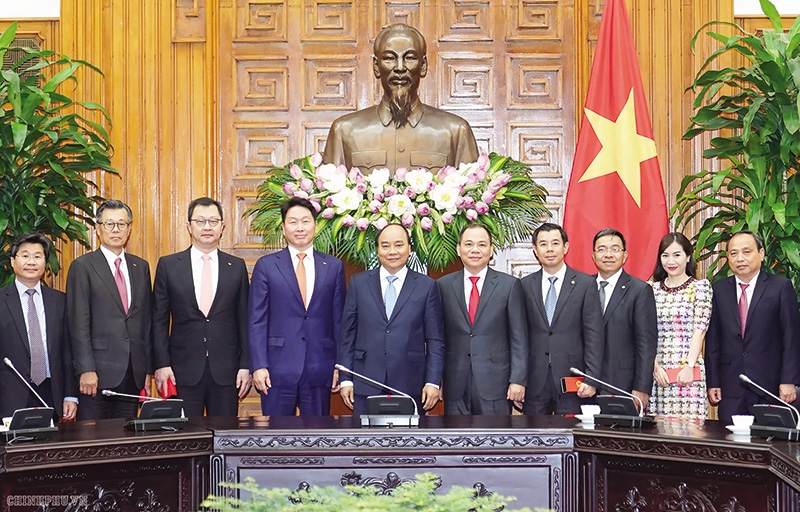South Korea’s supportive M&A plans
 |
| SK Group leaders last week met with Prime Minister Nguyen Xuan Phuc in Hanoi |
There is little doubt that Vietnam is a vibrant country with a thriving economy, and definitely one of the most attractive investment destinations in the world for South Korean investors.
A recent headline titled “Now, I am Mr Vietnam” refers to the SK Group chairman’s keen interest in Vietnam, given that SK Group last month spent $1 billion in exchange for 6.15 per cent of Vietnamese conglomerate Vingroup. Beyond this case, we believe that this headline very well sums up how South Korean companies view Vietnam nowadays.
 |
In 2018, South Korea ranked second among 112 countries and territories that had invested in Vietnam, with $7.2 billion, or 20.3 per cent of the total inbound investment. At the same time, South Korea was the second-largest trade partner of Vietnam, with total bilateral trade reaching $65.7 billion, accounting for around 14 per cent of Vietnam’s total import-export value.
Looking back, over the period of Vietnam’s 30 years of attracting foreign investment, South Korea took the lead with $62.5 billion, or 18.3 per cent of the total investment in the country.
Indeed, Vietnam stands at the centre of South Korea’s New South Policy, which was launched in 2018 to strengthen political and economic ties with the ASEAN. The South Korean government realised they have to diversify markets for growth and this is where the bloc, which includes Vietnam, stands out due to its high growth. This is a stark contrast to mature markets such as Europe, the United States, and even South Korea itself, where growth has stood at only 2.2 or 2.3 per cent. The South Korean president has paid several visits to Vietnam and continuously encourages businesses to go overseas and capture the opportunities in Vietnam.
In line with the government’s New South Policy, more South Korean companies and their supply chains are moving to Southeast Asia. Among them, Vietnam is the most important market.
Those are some of the key factors that make South Korean businesses invest in Vietnam. The attractiveness of the Vietnamese economy is widely known – political stability, business-friendly government policies, highly skilled labour, competitive wages, young demographics, and free trade agreements. South Korean businesses see in Vietnam a lot of similarities in culture: hard-working, disciplined people, and the environment is very safe to invest.
Policy successes
According to research conducted by a government-affiliated research centre, South Korea’s investment in the ASEAN after the New South Policy was launched went up by 16.7 per cent compared to 2017. Vietnam accounted for half of the investment, followed by Singapore. Investment in Vietnam marked a significant growth of 60.3 per cent in 2018, with the amount reaching $3.16 billion. Another factor for investors’ enthusiasm is an increase in manufacturing costs in China, driven by rises in property prices and wages. Businesses that have set up in China can take advantage of their existing supply chains there when building factories in Vietnam. The “China+1” strategy remains an on-going tactic for South Korean and other conglomerates going forward.
Even before the China-US trade tensions, a lot of foreign investors already looked into diversifying their businesses from China to Vietnam because of rising labour costs in China. Trade tension only accelerates that kind of diversification from China.
There is one other interesting trend that should be noted. The South Korean government recently put restrictions on the total working time in the country, and minimal wages were substantially increased. These labour rules make it harder for small- and medium-sized enterprises to hire in South Korea, which prompts them to move their factories to other countries like Vietnam.
Attractive sectors
South Korean businesses are quite diversified in terms of investment in Vietnam. They can have direct investment or look into buying stakes in local companies. The sectors that attract the most investment from South Korean business are in manufacturing, especially in garments, fabrics, and basic production; and technology and IT, exemplified by Samsung and LG. Electricity is one of the most important investments of South Korean businesses into Vietnam.
Businesses also have strong interest in building up infrastructure in Vietnam, mainly revolving around seaports, airports, and highways. With the growth of the manufacturing sector, there will be a need for good logistics to support this growth.
Besides manufacturing, we also see South Korean companies are moving into other sectors like food or financial services, in order to capture new opportunities from Vietnam’s large population, rising middle-income class, and strong economic growth.
It is expected that the rush of South Korean companies into Vietnam will continue, and the type and areas of investment will be further diversified. In recent years, we’ve seen rising interest in the energy sector, given that Vietnam is now focusing on renewable energy, especially wind and solar power. The goal for Vietnam is to increase the renewable energy proportion to 30 per cent by 2030.
The Vietnamese government also talk about building smart cities in Hanoi, Danang, and Ho Chi Minh City. With the success of South Korea in building big cities, we believe their partners and investors can play an important role in helping Vietnam develop such smart cities.
So far, most South Korean conglomerates choose a mixture of organic growth and mergers and acquisitions. We can see that in some areas like real estate, infrastructure, and retail, South Korean investors normally look to partner with local companies. But for some other areas like manufacturing, companies can run their own businesses. In terms of people, we also see that South Korean companies are using more local experts in their management instead of using home-grown experts as previously.
Regarding challenges, we believe both sides should keep in mind differences in culture and policy. South Korean investors need to understand Vietnam’s local market and consumers, and the local regulation environment which might be frequently changing and subject to interpretation. Access to skilled labour is another problem that South Korean investors might face.
We also want to note that for conglomerates, their financing requirement can be quite complex, including project financing, advisory, and liquidity management. Not many banks here have the capability to support these complex requirements. From our perspective, a joint platform can make it easier for those South Korean companies to manage their treasury issues efficiently while investing in Vietnam.
| The 11th Vietnam M&A Forum The 11th Vietnam M&A Forum, co-organised by VIR and AVM Vietnam under the patronage of the Ministry of Planning and Investment, will take place at the GEM Center in Ho Chi Minh City on August 6. Themed “Going for Breakthrough”, the Vietnam M&A Forum 2019 will feature in-depth discussions on M&A opportunities in the new era, necessary changes to boost the Vietnamese M&A market, and how to create win-win partnerships. Activities at the event will include the main conference with leading experts from Vietnam and abroad; award ceremonies for the best M&A deals and advisors of the 2018-2019 season; a networking dinner; the bilingual M&A Outlook publication; and the M&A Masterclass for breakthrough growth. Investors and businesses can register for the event via these channels: Hotline: 024 – 2246 6968 | Email: maf@avm.vn | www.mavietnamforum.com |
What the stars mean:
★ Poor ★ ★ Promising ★★★ Good ★★★★ Very good ★★★★★ Exceptional
Related Contents
Latest News
More News
- Vietnam bucking trend in the global M&A landscape (December 16, 2025 | 14:20)
- Sony Music Entertainment injects capital into Vietnam’s YeaH1 (December 16, 2025 | 09:00)
- Daikin expands Vietnam presence with Anh Nguyen deal (December 15, 2025 | 18:04)
- Astris Finance named among outstanding M&A advisory firms at Vietnam M&A Forum (December 12, 2025 | 12:00)
- UOA recognised for standout M&A deal in Ho Chi Minh City (December 12, 2025 | 11:32)
- Japanese investors pursue M&A strategies with long-term vision in Vietnam (December 11, 2025 | 12:14)
- FiinRatings wins M&A award as S&P deal strengthens Vietnam’s credit market (December 10, 2025 | 18:52)
- Unpacking new momentum in Vietnam’s M&A market (December 10, 2025 | 09:59)
- Landscape strong for domestic acquisitions (December 09, 2025 | 15:34)
- Vietnam’s M&A market opens new opportunities amid strong economic momentum (December 09, 2025 | 15:00)

 Tag:
Tag:


















 Mobile Version
Mobile Version